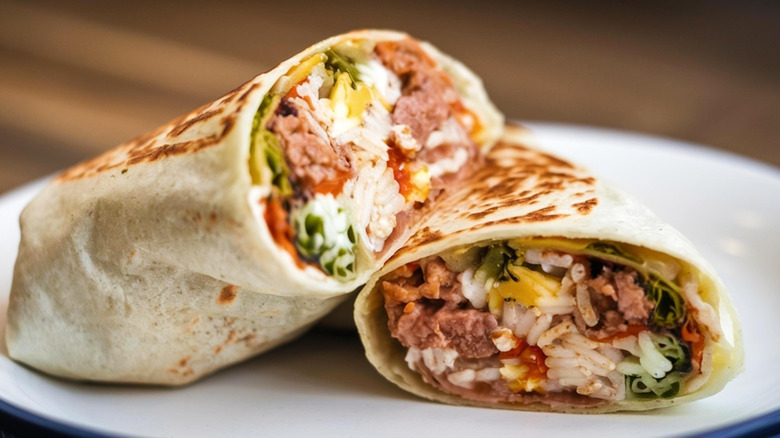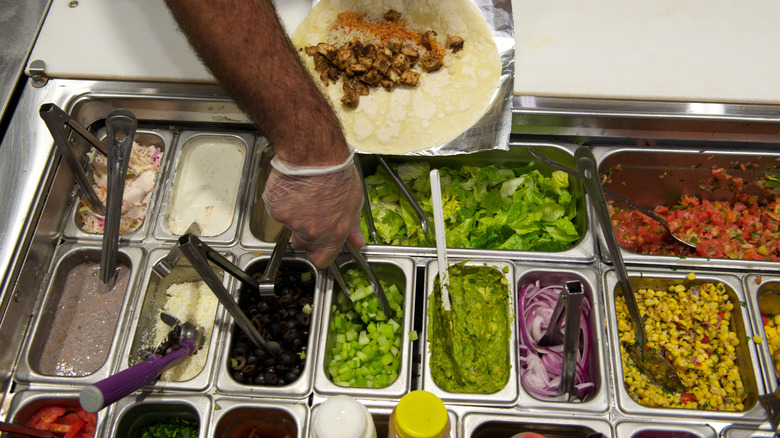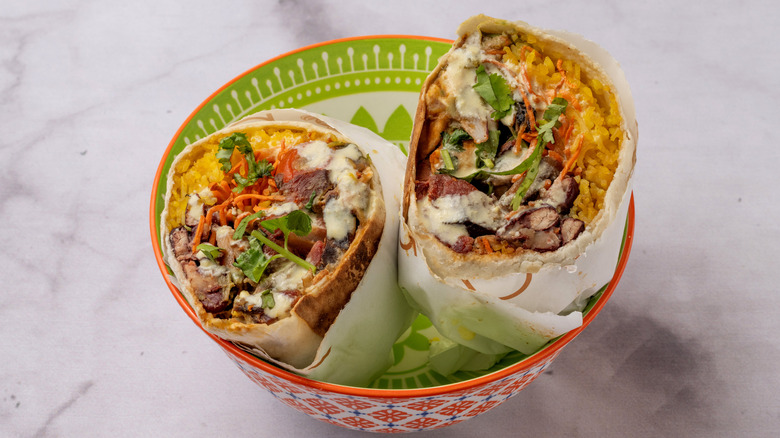The Best Burritos Don't Skimp On The Seasoning
Restaurant-quality burritos are deceivingly simple. But, for some reason, when we try to imitate them at home, they can fall flat on the flavor. That's because seasoning is the secret backbone of any great burrito — without it, even the freshest ingredients or perfect cooking execution can result in a less-than-ideal burrito.
Restaurants like Chipotle understand this concept well, which is why the best burritos have seasoning on each ingredient. It can be tempting to throw plain rice, beans, meat, and cheese into a tortilla and douse it in salsa as a way to add flavor, but this is a mistake. Salsa should act as a complement to the flavors and textures of the main ingredients but shouldn't be the primary source of taste. Salsa shouldn't mask the flavors of the core components. Rather, it should add a new layer of flavor to every bite.
A burrito doesn't have to be complicated to be good — even if you season just a few basic ingredients, you will still have a flavorful meal. In fact, one of the most simple burritos is called Mexican style, and it only features one flavorful meat filling, such as carnitas or birria. Remember bean and cheese burritos from childhood? These were so delicious because of the super-flavorful beans that were complemented by creamy cheese and a scoop of fresh pico de gallo.
How to season each burrito ingredient
Before seasoning your burrito ingredients, decide on your burrito preferences. Team rice or no rice? Whole beans or refried? Some burrito-philes prefer only warm ingredients, while others love the addition of fresh vegetables and toppings. Maybe a Mission-style burrito — the giant variety stuffed full of beans, rice, meat, guacamole, and sour cream — is more your vibe. Keep in mind that the same concept of seasoning each ingredient can be used to create an amazing breakfast burrito.
Start with the base: Rice, often thought of as a filler, can be cooked with cilantro, lime, cumin, or other seasonings. It's common for restaurants to also cook rice in a chicken broth (vegetable broth is fine, too!) as a quick flavor hack. Rice should be seasoned but not spicy to allow for the addition of a spicy salsa or grilled chile, if desired. Beans shouldn't be an afterthought, either. It's easy to find pre-seasoned canned beans at the store, but if you're cooking black beans or pinto beans from scratch, add in aromatics, such as onions, garlic, cumin, and bay leaves.
Whether your main filling is beef, chicken, or a plant-based option like tofu or vegetables, use key ingredients in Mexican cooking like cumin, chili powder, garlic, paprika, and oregano. Meat and tofu also take on more flavor if they're left to marinate for a few hours in these spices alongside citrus juices like lime or orange to tenderize the meat and add brightness.
Maximize the flavor of your tortilla and extra toppings
Now that you've seasoned the core burrito components, any fresh additions you plan on adding won't need much seasoning. Some ingredients, such as onion, corn, cilantro, tomato, or shredded lettuce, can benefit from simple upgrades. For example, you could char-grill your corn or buy a pre-charred package at the grocery store. A sprinkle of salt and pepper or a dash of lime juice can enhance the flavors of any fresh ingredients. Instead of diced and raw onions, try grilling them or adding pickled red onion for an acidic burst of flavor. Guacamole, sour cream, and, of course, salsa provide plenty of flavor on their own, so no need for changes here.
You may not have thought to season the tortilla, but many taquerias and Mexican restaurants quickly heat tortillas on the grill to give them a flavorful char. To make a burrito dorado style (dorado translates to "golden"), you can also cook a complete, wrapped burrito in hot oil until it's slightly browned and crispy on the outside.


